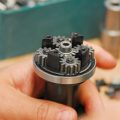To tell the truth: I have never managed to understood those who refuse to embrace new technologies, given that nowadays it is basically impossible to do without them.
Having said this, I asked myself a question. A question I would like to share with you:
if you think of the reality in which you work, understood as a set of individual activities that converge in the various operational areas, is there still something that works better if it’s done “the old way”?
Well, if I think of my company, if I think about MICROingranaggi, the answer is yes. Or, rather, yes for the moment.
As you know, since the end 2019 MICROingranaggi became a certified intelligent factory plant, in line with the Industry 4.0 standards. Well, this transition has radically changed the processes and the modus operanda in all our departments. Or, rather, almost all.
In fact, if I think of, for instance, the assembly department, I have noticed that the transition to Industry 4.0 standards has not in fact changed its activities. The only differences compared to before refer to a swifter management of production orders thanks to the new management system. But not because an operation such as that of the assembly lines cannot be automated further;
it is purely the nature of our production that still prefers the manual skills of our operators.
Some time ago I wrote that the manual assembly operations that our operators perform on a daily basis were so many (screwing, gluing, welding of electrical cables, positioning of seals or couplings, lubrication, fitting of bushings and bearings, reading or verification of values indicated on tools and instruments etc.) that rendering operational a collaborative robot each time for each of these tasks would require gripping or mechanical connection, pneumatic, optical and other equipment, which should compensate for the infinite possibilities of the human mind, senses and hands, and that would represent a cost needing very careful assessment. Especially if we are talking about rather small production batches.
I therefore reiterate:
as far as assembly work is concerned, we continue to prefer the manual skills of our operators.
Moreover, in some cases it is the actual customers that require the visual verification of the work performed by the technician, work that – if you want – could also be assigned to a video camera, but there is another important factor to be taken into account.
the use of a traditional assembly line, as well as a collaborative robot, is only justified in the case of medium-large or at least frequently repeatable series, or in the case of heavily taxing or dangerous operations.
So we’re back to the initial question: is there still something that works better if it’s done “the old way”?



